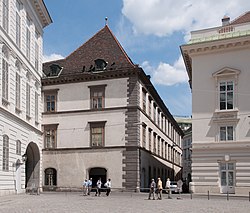| Stallburg | |
|---|---|
 | |
| Coordinates | 48°12′25.92″N 16°22′1.92″E / 48.2072000°N 16.3672000°E / 48.2072000; 16.3672000 |
| Built | c. 1558–1565 |
| Architectural style(s) | Renaissance |
 | |


The Stallburg is a renaissance-style building in the Vienna city center located between Josefsplatz and Michaelerplatz. It is part of the Hofburg Palace.
Formerly the living quarters of Archduke Maximilian , later Emperor Maximilian II, it was built around 1558–1565 as a residence. From 1659 to 1776 it housed the art collection of Archduke Leopold Wilhelm, called the Stallburg gallery. This collection forms the core of the later Kunsthistorisches Museum from 1889. Later the building became the Imperial Stables used to house the imperial horses, and even today it is still used by the Spanish Riding School (Spanische Hofreitschule).
Before moving to Vienna in 1659, Archduke Leopold Wilhelm formed his art collection of 1400 paintings in Brussels, where David Teniers the Younger painted views of his Brussels gallery, which are now spread among various collections. He made many miniatures of the paintings for use as models by engravers and published a catalog of the Italian paintings in the 1660s called Theatrum Pictorium.
-
 The Archduke Leopold Wilhelm in his Painting Gallery in Brussels, Prado
The Archduke Leopold Wilhelm in his Painting Gallery in Brussels, Prado
-
 Gallery of Archduke Leopold Wilhelm (Brussels), Royal Museums of Fine Arts of Belgium
Gallery of Archduke Leopold Wilhelm (Brussels), Royal Museums of Fine Arts of Belgium
-
 Neues Schloss Schleißheim
Neues Schloss Schleißheim
-
 Kunsthistorisches Museum
Kunsthistorisches Museum
-
 Gallery of Archduke Leopold Wilhelm in Brussels (Vienna), Kunsthistorisches Museum
Gallery of Archduke Leopold Wilhelm in Brussels (Vienna), Kunsthistorisches Museum
-
 Gallery of Archduke Leopold Wilhelm in Brussels (Petworth), Petworth House
Gallery of Archduke Leopold Wilhelm in Brussels (Petworth), Petworth House
-
 View into the picture gallery of the Archduke Leopold, by Nicolas van Hoey in Teniers' catalog of paintings in 1673
View into the picture gallery of the Archduke Leopold, by Nicolas van Hoey in Teniers' catalog of paintings in 1673
Charles VI

After Teniers, Anton Joseph von Prenner was the next to make an illustrated catalog of the paintings there in the 1720s, which included the additions of the Naples collection of Charles VI, Holy Roman Emperor. Charles VI commissioned Ferdinand Storffer to oversee color miniatures as well as engravings for it. The resulting document "The Newly Arranged Inventory of the Imperial Paintings Gallery in the Stallburg" appeared in four volumes from 1720 to 1733. Charles VI also commissioned Francesco Solimena to commemorate the re-arrangement of the gallery with a painting.
The name of the building comes from the horses of the imperial family, who were housed on the ground floor under the reign of Emperor Charles VI. The fountain with wrought iron railings in the middle of the yard was built in 1675. The building was heavily damaged in 1945 just before the end of the Second World War by bombs but was faithfully restored during the years 1947–1948. The passage to the arcades between Hofburg and Stallburg was opened on July 1, 1948.
Today Lipizzaners of the Spanish Riding School are housed there, the associated stud is located in Piber in Styria. From Reitschulgasse one can see the yard. Next to it was the now closed Lipizzan Museum.
References
- History of the collections of the Kunsthistorisches Museum
- Davidis Teniers Antverpiensis, pictoris, et a cubiculis ser.mis principibus Leopoldo Guil. archiduci et Ioanni Austriaco, Theatrum pictorium : in quo exhibentur ipsius manu delineatae, eiusque curâ in aes incisae picturae, archetipae italicae, quas ipse ser.mus archidux in pinacothecam suam Bruxellis collegit, by Teniers in 1673 on archive.org
External links
- Vienna website
- Catalog of the collections in 1886, archive.org
- Ferdinand Storffer, Neu eingerichtetes Inventarium der Kayserlichen Bilder Gallerie in der Stallburg, 3 volumes, 1720-1733
- The Restoration of Paintings at the Beginning of the Nineteenth Century in the Imperial Gallery by Alice Hoppe-Harnoncourt
- David Teniers and the Theatre of Painting, exhibition 19 October 2006 to 21 January 2007, Courtauld Institute of Art
48°12′26″N 16°22′02″E / 48.2072°N 16.3672°E / 48.2072; 16.3672
Categories: